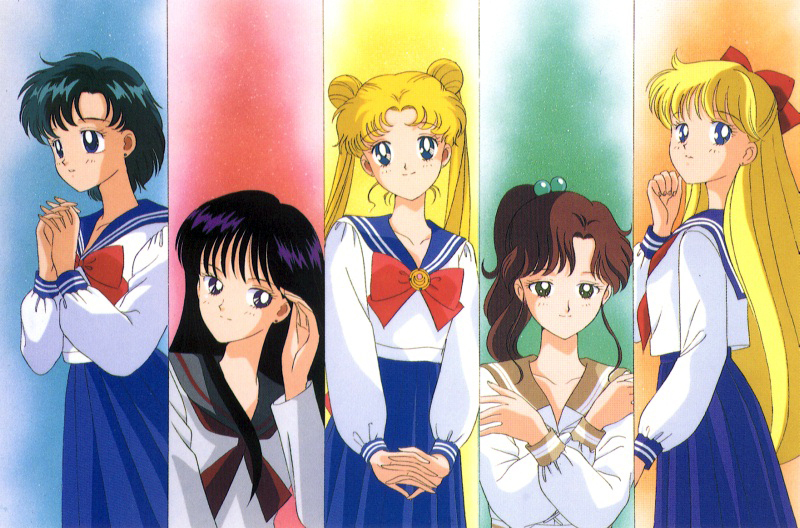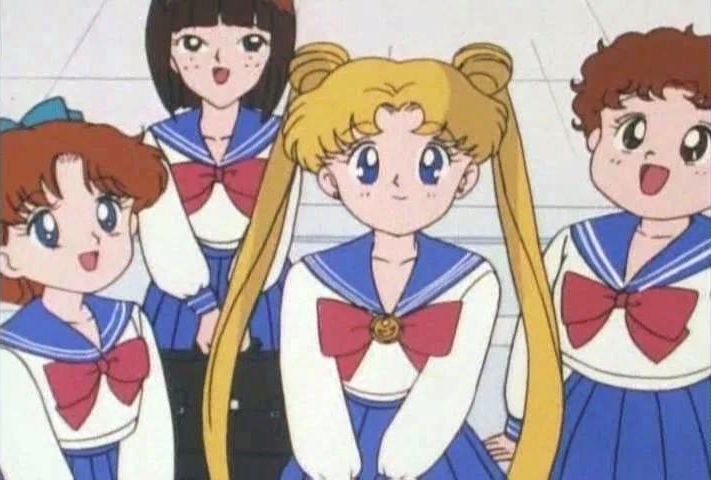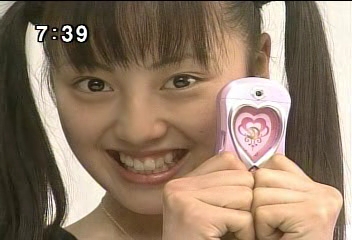When the Sailor Team aren’t being shown at school, the vast majority of the misadventures our girls of love and justice get into seem to take place on the way to – or from – school. While the sailor-inspired school uniform is obviously an important part of the story’s theme, the schoolwork itself plays a very minor role in the series. So why are the characters always at school, then?
Before you say “because it’s a cartoon, you jerk!” – and you wouldn’t be entirely wrong, on either point – it’s probably worth pointing out that there actually is some historical significance behind this.
Today we’re going to take a look back at the early 90s, and how the Japanese Ministry of Education’s policies affected the world of Sailor Moon. If that doesn’t get your blood pumping, I don’t know what will!
It’s actually kind of funny when I stop and think about it, because when I first started getting into Sailor Moon, and anime in general, this was somewhat “well-known” trivia that was shared among fans.
At least it was among the fanfiction-writing circles,1 seeing as you kind of needed to know a little something about the school system if you were going to write stories set in Japan.
So what am I talking about? Well, my dear reader, I’m talking about the 5-day school week that we are all so familiar with.
You see, going to school five days a week is actually relatively modern to the Japanese school system. Even nowadays, Saturday is still something of a grey-zone in Japan when it comes to being a day off.2 If a national holiday falls on a Saturday, for example, sucks to be you. There is no “make-up” holiday on the preceding Friday or following Monday to compensate for this like there is on Sundays.
The same goes for many corporate overtime policies, where Saturday pays out at a different overtime rate than Sunday or holiday hours.3 But that’s neither here nor there.
What is important to know is that, back in 1992, Japan was still enforcing a 6-day school week, with only the second Saturday of every month being a holiday – and that was only started in September 1992!4 Another day off, the fourth Saturday of the month, was later added from April 1995.5
That means that over the course of the series, on average Usagi and the Sailor Crew had the day off from school (manga arc name in parentheses):
- Sailor Moon Classic (Dark Kingdom)
- First half: 4 days a month
- Second half: 5 days a month
- Sailor Moon R (Black Moon): 5 days a month
- Sailor Moon S (Infinity): 5 days a month
- Sailor Moon SuperS (Dream): 6 days a month
- Sailor Moon Stars (Stars): 6 days a month
So you see, unless this was over summer or winter vacation, back when the series was on the air, our favorite Sailor Soldiers actually didn’t really have that much time to themselves. This kind of explains why, except when they were going off on grand adventures, their lives seemed to revolve almost entirely around school. Because, you know, their lives actually did revolve around school.
When did this all change? Well, it wasn’t April of 2002 when the Ministry of Education promulgated6 a revision to the Ordinance for the Enforcement of the School Education Act, the Japanese law which sets forth the rules for public schools, from elementary to high school.
While this seems like – and probably is – a pretty minor change in the grand scheme of things, what makes it interesting is it’s yet another way in which the original telling of the Sailor Moon story differs with the 2003 live-action version and the more recent Sailor Moon Crystal series.
Not only did the live-action Usagi have her very own mobile phone, when ’92 Usagi would have been happy just to have a pager, but she was going to school far less than her predecessor.
Live-action Usagi was also on target to graduate in a horribly depressed job market and facing the collapse of many multinational banks, but let’s not worry about that.7
So there you have it, yet another small way how Japanese lawmakers inadvertently affected the world of Sailor Moon! It may be a tiny detail, but when you take all these “tiny details” together as a whole, it’s actually pretty interesting to consider just how different of a character Usagi is in each of the consecutive reboots of the series.
This is probably a long-shot, since I doubt few other people have an obsession on late-1980s to early-1990s Japan like I do, but if you have any questions about what the situations were like back in Japan at that time, I’d love to hear them!
References:
- Yes, I wrote fanfiction. No, I will not say what my pen-name was. I will take it to the grave. ↩
- See Is Saturday a Holiday in Japan? ↩
- Source: Me? I’ve worked in Japan quite awhile and have seen a lot of employment contracts ↩
- See Five Day School Week (Wikipedia) ↩
- See History of the Five Day School Week ↩
- Yes, promulgate is a word; see Promulgate ↩
- See the Lehman Shock (Wikipedia) ↩






YES! I DID notice that PGSM Usagi & Co. we’re pictured at school way less than in the anime!! I always just assumed lazily that it was just animation convenience to have them constantly in their uniforms or maybe ’cause they wanted the live action girls to appear more stylish… Thank you for solving this mystery!!
Whoa, so people actually DO sometimes wonder about the totally random stuff I write on this blog? =D You have no idea how happy this makes me.
Okay, but can you explain why Chibiusa was the only one going to school in SuperS? Haha
I’ve been wondering that as well as why did we see Chibiusa going to school during Super S when all of the Senshi went to school 6 Days a week ?
I don’t have any specific questions about circa-1990 Japan but I’d be interested in hearing any bits of trivia you know about. You run the website, you can have an article that doesn’t mention Sailor Moon if you want to!
My other favorite anime series is Kimagure Orange Road which takes place in 1987. Obviously the fictionalized worlds of KOR and Sailor Moon aren’t fully realistic portrayals of the real Japan, but that time and place will always be one of those special “I wish I could visit that era” locations for me.
The look and feel of KOR reminds me of the same time period in the US, so it seems that Japan and the US both being first world countries enjoyed modern development at about the same pace, but I suspect there were some interesting differences. One that I know of is how pagers were huge in Japan and people developed a number coded pager-language that was a precursor to modern texting, https://gizmodo.com/5609205/how-japanese-schoolgirls-started-a-mobile-phone-revolution while pagers were only moderately used in the US. It’s interesting how that was such a massive trend, but died nearly instantly once cell phones arrived.
BTW I kinda wonder why KOR didn’t become a bigger hit over here. Sure, it’s not as exciting as Sailor Moon, and it came out too early to fully benefit from the burst into popularity that anime had in the mid-90s US. I’m not surprised it wasn’t at Sailor Moon levels of popularity. But it had that same kind of heart to it, the same storytelling style… it’s about teenagers and love and there are super powers mixed into it too, and it even shared some of the same voice actors as Sailor Moon. Of course some western anime fans have seen it, but it’s nothing at all like Sailor Moon where almost every single anime fan has seen some of it, and isn’t often remembered as one of the classics when I think it deserves to be. Anyway, enough ranting from me.
If you have any interesting ideas for an article please go ahead and write about it! I enjoy your informative writing style and it doesn’t always have to be about Usagi and her friends.
Here’s a random question for you, answer if you like!
I just watched the episode in season one where the Sailors pretend to mutiny against Sailor Moon, to trick their way into the Dark Kingdom.
The youma pretends to be a gossip reporter, right? But dang is the outfit that she wears as a reporter weird. Bell bottoms with stars, a headband and vest like some kind of hippie…. what’s up with that? Was this a reference to some kind of notable reporter, or a character from another show with a specific 1970’s motif?
Not what I’d imagine a generic journalistic professional would dress like. Do you know anything about this, by chance?
Lol. XD I wonder how long school weels are in Crystal Tokyo?? XD
I wish we knew more of the Silver Millennium in both past and future.
=3
I know, right? It’s too bad that we find out so little about the Silver Millennium and Crystal Tokyo…
Though it begs the question considering that you written about the The Real World Stories Behind Sailor Moon . What is your theory about Silver Millennium and Crystal Tokyo ? What I mean by that is what do you think happened to them ?
Hmm, I’m not sure I understand your question. With the Silver Millennium, we know that it fell during the battle with the Dark Kingdom and that basically everything was destroyed and then reborn. With Crystal Tokyo, though, I guess the series isn’t really too clear. We’re left to assume it’s a “happily ever after” kind of deal, but that’s kind of vague. And with the introduction of Sailor Cosmos, it seems to imply that things didn’t go so well.
What I meant was what’s your opinion on the Silver Millennium and Crystal Tokyo came to be ? I was curious to hear your thoughts considering that series isn’t really too clear .
I know, right? I really wish we knew more about the Silver Millennium and Crystal Tokyo!!
What were the Game shows like in Japan in the Japan ?
What was Prime-time television like back in Japan during that time?
What were Arcades like in Japan in the 1990’s?
Hmm… all interesting questions! The arcade one in particular is something I’ve been meaning to talk about, since much is made about Usagi (and Minako in Sailor V) going to arcades!
What was music like in Japan in the 1990’s?
What was Sports like in Japan in the 1990’s?
What was the difference between general trends in Japan and the United States in the 1990’s? Just to give a clear perspective .
Unfortunately, MEXT is slowly bringing Saturdays back :/
And people ask why I don’t want to put my daughter in Japanese schools… =D
At least I have international/private school options (albeit insanely expensive options) in Tokyo.